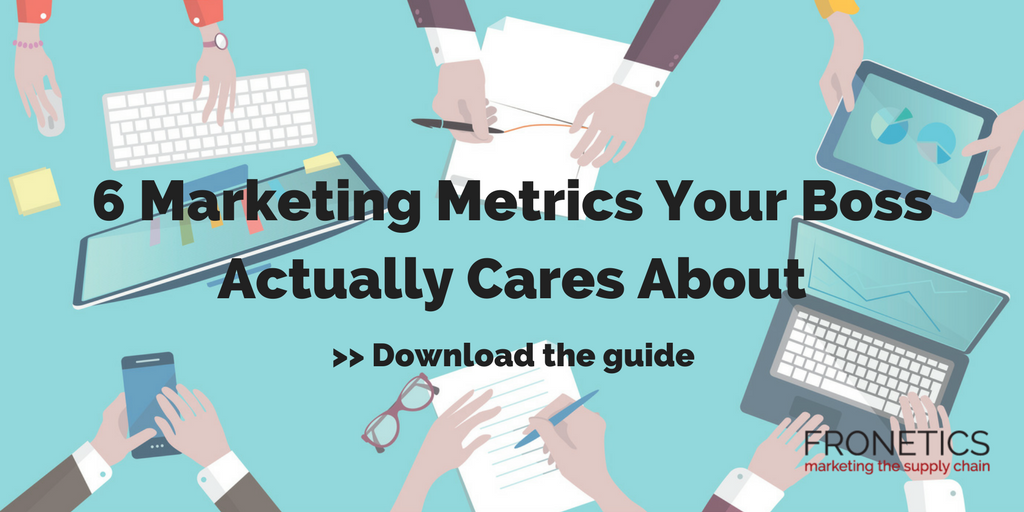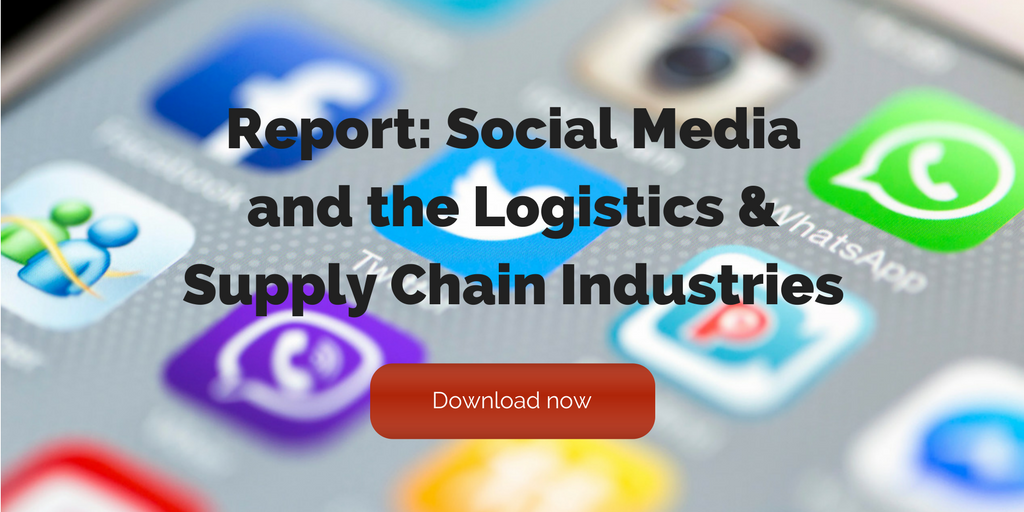
by Fronetics | Mar 15, 2018 | Blog, Content Marketing, Logistics, Marketing, Strategy, Supply Chain
Here are four simple steps to help you measure your company’s content marketing ROI and the success of your strategy.
Lean-startup pioneer Eric Ries said, “The only metrics that entrepreneurs should invest energy in collecting are those that help them make decisions.” In other words, measure the things that will tell you if an effort was profitable so you know where to put your time and money.
But most companies aren’t using the right metrics to track their content marketing ROI. For example, 83% of B2B enterprise companies (over 1,000 employees) use web traffic as their main metric for measuring content marketing ROI. A spike in homepage hits could be the result of your hard work, but it could also be ghost spam, or even both! So clearly, web traffic isn’t the most reliable metric.
Content marketing ROI is harder to quantify than checking a few quick numbers. But don’t give up hope. In the article How to Measure Content Marketing ROI: A Simple 4 Step Process, marketing consultant Bill Widmer breaks down a simple, four-step process that will quickly and effectively measure your content marketing ROI.
What is content marketing ROI?
Content marketing ROI is how much revenue you gain from content marketing in comparison with what you spend on creating and distributing content. It’s an actual percentage that shows how much revenue you gained vs. how much money you spent. And for a lot of businesses (and bosses), this percentage is very important. They want you to be able to prove that the marketing dollars that are going into your content marketing strategy are actually pulling in new business.
Every company has specific key performance indicators (KPIs) that help shape their marketing strategies. Here at Fronetics, we believe that your content marketing strategy should take these KPIs into consideration when thinking about your ROI:
- Website traffic
- Leads generated
- Conversion rate
- Direct sales
Obviously content marketing has more benefits than these four KPIs demonstrate — including better customer retention, brand awareness, and improved SEO — but to begin to measure your ROI, let’s focus on these four main points.
Measure content marketing ROI in 4 simple steps
1. Download your reverse goal path data.
Andy Crestodina, co-founder and CMO of Orbit Media, suggests:
- Go to your analytics dashboard. Set the date range for at least a year.
- Go to Conversions > Goals > Reverse Goal Path.
- Add a filter like “/blog” so only blog posts show up.
- Sort by Goal Completions.
After this step, you’ll be able see which of your posts have driven the most conversions. But you can’t stop there. These are simply conversion numbers. We want those numbers to become conversion rates, so let’s keep going.
2. Download your pageview data.
In order to calculate a conversion rate, you need to know pageviews. Here’s how to get that information:
- Go to Content > Site Content > All Pages.
- Filter with “/blog” to get only blog posts.
Download this data into the spreadsheet from step one.
3. Get your conversion rate.
Now here’s a little math for you. Divide the data in the “conversions” column by the number in the “unique pageviews” column. This will give you your conversion rate per blog post.
This will show you what your best-performing pieces of content are, and what posts need to be updated to gain more views and shares.
This information will give you valuable insight into the topics that your target audience are reading about and how you can better plan for high-ranking content in the future.
If you have posts or pages that are older — like over a year — and they haven’t gotten any views or conversions, it’s time to think about reworking them to have more appeal to your target audience.
For your actual percentage, you’ll need to calculate how many of these leads have converted to sales.
4. Calculate content marketing ROI based on lead conversions.
Here’s where things get a little more complicated, but still very manageable. You need to start putting tags on your leads according to the content they came from.
You can use programs like WordPress or Blogger to help you automatically tag any leads that came from a specific form. Assuming the form correlates to a single blog post, you will know that any leads with that tag came from that post.
You can also connect your leads with a CRM, such as HubSpot or SalesForce, and track which leads came from specific emails. These programs easily integrate with your analytics and email marketing platforms for up-to-date numbers and data.
Related posts:


by Fronetics | Mar 7, 2018 | Blog, Content Marketing, Logistics, Marketing, Social Media, Strategy, Supply Chain
Linkless backlinks, or mentions of your business without a hyperlink to your webpage, are now a more effective way to improve your ranking with search engines.
For years Google has used backlinks to rank webpages. Backlinks are any link on another website that points (or links) back to your website. Unfortunately, search engines began to use backlinks as a bit of a popularity contest: The more you had, the more popular your website became.
Businesses quickly understood the loophole in search engines’ algorithms. They could buy, influence or even create relationships with other industry businesses for the sole benefit of getting links to their websites. It didn’t take long for search engines to catch on.
Google has spent years reworking the way it ranks backlinks and trying to penalize brands that pay for or create free links through unethical relationships. But where does that leave the rest of us that are working to create high-quality content in hopes of increasing our SEO rankings?
Linkless backlinks are the future of SEO rankings
You might be asking yourself what is a linkless backlink? Good question.
Linkless backlinks are mentions of your business or brand without a hyperlink to your webpage. In a keynote speech in September 2017, Gary Illyes, a webmaster trend analyst for Google, said:
“Basically, if you publish high-quality content that is highly cited on the internet — and I’m not talking about just links, but also mentions on social networks and people talking about your branding — then you are doing great.”
It all comes down to mentions of your brand on reputable websites. And I don’t just mean backlinks to your webpage. Other sites’ tweeting about your products or mentioning you on their Facebook News Feed can all lead to increased rankings on Google and other search engines. Sounds easy, right?
How to make linkless backlinks work for you
The principles that help you gain backlinks are still true for gaining linkless backlinks. You want to focus on creating the most accurate, high-quality content you can. Create videos and infographics for your website to add visual appeal. And collaborate with other industry leaders to reach new audiences.
But there are a few other tips you can use to help boost your SEO ranking with linkless backlinks.
3 tips for building a strategy for linkless backlinks
1. Work to increase brand awareness and reputation
The foundation of linkless mentions is reputation building. Search engines are looking for authentic mentions of products and brands in content that helps build authority around an industry topic.
Increase your brand awareness by growing your social media presence, by encouraging followers and loyal customers to write online reviews of your products and services, and by participating in collaborative content marketing.
2. Track brand awareness and mentions
You’re working hard to create content that has a far reach across many platforms. It’s a key step in gaining exposure among potential customers and earning new business. This process is called brand awareness, the extent to which consumers are familiar with your brand. And for linkless backlinks, it’s imperative that you’re tracking all of your brand mentions, not just links.
There are several tools to help you track brand mentions online. Here at Fronetics, we prefer the ease of Google Alerts, which sends you a message when someone mentions your brand online. We also use Hootsuite, with which you can track brand mentions, as well as keywords and phrases, across all of your social media platforms.
3. Stay on top of negative mentions
Blog comment sections and social media channels offer an open avenue for customers to discuss their thoughts about your company for all the world to see. And, unfortunately, one negative comment can be infinitely louder than one hundred positive ones. The potential impact it could have on business is scary.
But that doesn’t mean you should delete or ignore every unfavorable brand mention. In fact, companies can use negative online comments as an opportunity to exhibit top-notch customer service and much-appreciated transparency in the way they do business.
Be diligent in monitoring brand mentions and respond quickly to resolve any issues that arise. Responding promptly and effectively to negative feedback online shows your commitment to customer service and transparency.
The art of SEO building is a tough craft to master. As algorithms evolve, it’s important for brands to stay aware of these changes and focus on what they can do to help boost their rankings.
The more buzz around your brand, the better your ranking will be. So make sure you’re utilizing all the different ways to help boost your SEO ranking, including linkless backlinks.
Need more help with SEO? We’ve done the research, so you don’t have to. Have a look.
Related posts:


by Fronetics | Dec 13, 2017 | Blog, Marketing, Social Media
Here are our 10 most-read social media posts of 2017.
Today, more than ever, companies are turning to social media to engage with customers and reach new audiences. Brands are using newer technologies to push content marketing to new levels. And it’s working.
Looking at this list, I notice the popularity of posts about how to utilize social media to grow leads and close deals. Knowing when and where to post isn’t enough; with constantly changing platforms, companies need to stay on the pulse of social media to stay ahead of their competitors.
At Fronetics, we hope to serve as an educational resource for companies within the logistics and supply chain industry. Always feel free to reach out and ask us a question or request a blog post if there is a topic about which you need more information. In the meantime, here are the 10 most-read posts about social media from our blog in 2017.
Top 10 social media posts in 2017
1. This is How Often B2B Businesses Should Post on Social Media
Keep these best practices in mind when determining how often to post to social media. It’s not enough to just create interesting and pertinent content; you have to put it out there to reach your target audience. Moreover, the content needs to be delivered consistently over time, at the right time, and in the right place. Read more.
2. 4 Tools to Determine the Best Time to Post on Social Media for Your Business
Find out when your target audience is most active on different social media platforms by using these 4 online tools. It’s not enough to curate content for your social media platforms. Today’s social media users expect fresh, innovative ideas around the clock. And when this content is being shared is just as valuable as what is being shared. Read more.
3. Social Benchmarking: How You Know You’re Killing it on Social Media
Rival IQ’s Danica Benson discusses the importance of social benchmarking and offers three steps for getting started. Benchmarks are key when interpreting data. Organizations of all kinds — large corporations, small privately-owned business, nonprofits, and even sports teams — need to measure their performance to see if they’re efforts are leading to success. Read more.
4. The Best Time to Post on Social Media: A Comprehensive Study
When you are posting on social media could be as important as what you’re posting, and this CoSchedule study attempts to determine the best time to post. Timing is everything. And that statement especially holds true when it comes to posting content to social media. There’s no point in putting in the time and effort to create informative blog posts, inspirational tweets, or captivating Facebook posts if you’re not getting the most exposure you can out of your social media outlets. Read more.
5. Instagram Stories: How the Supply Chain Can Use Them to Engage Prospects and Customers
Instagram Stories offer an on-trend platform for delivering targeted content to B2B buyers and building brand awareness with potential customers. If you haven’t considered using Instagram as part of your social media marketing program, it might be time to change your mind. Read more.
6. 7 Must Follow Twitter Accounts for the Supply Chain Professional in 2017
Turn to these 7 Twitter accounts for news, insights, and thought leadership in the supply chain space. Twitter is a platform for socializing, entertainment, breaking news, lead prospecting, and much more. But Twitter is only as useful as the people you follow. So how do you choose between the 317 million monthly active users? Read more.
7. Leveraging Social Media in the Consumer Electronics Industry
Here are two examples of consumer electronics companies leveraging social media to reach their target audiences, build brand awareness, and drive sales. Supply chain businesses understand that social media is an important marketing tool in today’s marketplace. The consumer electronics industry is no different: Participating in social media has never been more necessary. Read more.
8. #LeggingsGate: The Importance of Emotional Intelligence in Social Media Management
United Airlines failed to apply emotional intelligence to its social media management and will continue to suffer the consequences. The recent #LeggingsGate controversy — in which a United Airlines gate agent refused to allow two young girls flying on friends-and-family tickets to board a flight because they were wearing leggings, which violated company dress code — really got our office talking. The incident is a great example for all businesses on the importance of emotional intelligence in social media management. Read more.
9. Where on Social Media Will Competitors Be Next? Trends in Content Distribution Channels
Recent surveys show video platforms are the next big focus for marketers in terms of content distribution channels. We’re big advocates of social benchmarking against your competitors. But, just as much, we are always thinking ahead, trying to figure out where the industry is going next. It’s important to get ahead of the trends so that you can be right there leading the pack. Read more.
10. Facebook Breaks 2 Billion Users, Instagram Crushes Snapchat, and more Social Media News
In July’s social media news, platforms saw a rise in daily active users and broke records in more than one category. Once thought to be a passing trend, social media is nowhere near slowing down in terms of growth. Next Web reported that India has taken over as the largest audience of Facebook, beating out the U.S. with over 241 million active users. Active users in India are up 27% in the past six months, twice the rate of U.S. users. Read more.
Related posts:


by Fronetics | Dec 12, 2017 | Blog, Content Marketing, Marketing
Our most-viewed content marketing posts indicate that marketers are seeking solutions to improve their content marketing programs.
Supply chain and logistics marketers are increasingly seeing the value of content marketing. It is the most cost-effective method to earn leads and sales because it takes into account the way modern B2B buyers are making purchasing decisions (evaluating content they find on the internet).
Looking at our most-viewed content marketing posts this year, I see a trend: marketers are looking for solutions to improve their content marketing programs. I am currently working on our content calendar for 2018, so if there is anything specific you would like to know about, please feel free to email me with suggestions!
Top 10 content marketing posts
1) 4 Ways to Measure Brand Awareness
Building brand awareness is one of the key benefits of content marketing, but it’s notoriously difficult to measure. These four metrics can indicate that you are successfully drawing the public’s attention to — and heightening their knowledge of — your business. That will ultimately generate leads that turn into sales, which is the end marketing objective. Read full post
2) How to Write Better Headlines for LinkedIn Content in 2017
A study of 2016’s most popular content on LinkedIn used data to measure the most popular headlines and topics. The results are really interesting and say a lot about what content resonates with the general LinkedIn community. Tis post summarizes the most popular headline phrases and the most impactful headline words and topics, and suggests ow to use this knowledge to write more successful headlines for your LinkedIn content. Read full post
3) 4 Steps to Building a Successful DIY Content Marketing Strategy
Setting your content marketing strategy is a crucial first step in trying to reach your target audience. Before you begin writing blogs and posting tweets, you need to set goals. A content marketing strategy outlines the methods by which you will target, reach, and engage your audience. Here are four steps, outlined in the guide, to creating a successful foundation to your content marketing strategy. Read full post
4) Want More Leads? Write Better Content
All too often, marketers fall into the trap of sacrificing quality for quantity in their content writing efforts. It’s an easy mistake to make — the pressure to produce a constant stream of content can naturally lead to a drop in quality. But if you’re not writing high-quality, substantive content, you’re wasting time and energy. If you’re wondering whether your content might not measure up, ask yourself these six questions. Read full post
5) 7 Marketing Tasks Supply Chain and Logistics Companies Should Consider Outsourcing
Everyone needs a little help sometimes. In fact, 52% of B2B marketers attribute stagnancy in success to not having enough time devoted to their marketing programs, and 49% attribute stagnation to content creation challenges. Outsourcing marketing allows you to focus on insourcing your core competencies while delegating specialized tasks to external experts. And it’s important to note that you don’t have to outsource ALL of your marketing. Choosing several areas beyond your staff’s expertise or that are particularly time-consuming can help you improve your marketing efforts and take stress off an overworked internal marketing team. Read full post
6) 10 Stats You Should Know about the B2B Buyer’s Journey
Marketers need to be aware of the ways in which the B2B buyer’s journey has changed over the last decade. The vast amount of information available on the internet has afforded buyers a level of self-sufficiency that renders traditional sales models moot. It drives the need for new strategies, like content marketing and social media marketing. The latest B2B Buyer’s Survey offers insight into how B2B buyers are finding vendors, engaging with them, and — ultimately — deciding to work with one. Read full post
7) 3 Tools for Measuring Your Content Marketing ROI
Analyzing the right metrics is crucial to determining whether you are achieving content marketing ROI. According to our Social Media Use Report, 81% of respondents wanted a tracking and measuring tool to prove their ROI. Your resources are limited, so it’s crucial to evaluate your efforts with meaningful numbers that illustrate their effect on your bottom line. So what are they best metrics to use? Here are three of our favorite tools. Read full post
8) 3 Content Marketing Challenges Large B2B Enterprises Face
B2B enterprises with 1000+ employees face unique content marketing challenges that can hinder a program’s overall success. The Content Marketing Institute’s 2017 B2B Enterprise Content Marketing Report brings many of these issues to light. For example, pressure to produce results quickly is a death sentence for content marketing. And being forced to create content for a brand, rather than a specific audience, can be detrimental to content marketing results. Yes, challenges facing these enterprise marketers are often as large as the companies for which they work. This post looks at some of the reasons why that is, and a few solutions for solving them. Read full post
9) How Word of Mouth Can Work for You
Buyers value the opinions of peers and colleagues. In fact, B2B buyers rank it among their top three resources for information. And, in general, 82% of Americans seek recommendations when making a purchase of any kind. Make their chatter work for you. Here are three tips to turn word-of-mouth marketing into leads. Read full post
10) 3 Quick SEO Tips to Improve Your Blog Right Now
Content marketing aims to draw potential buyers who are searching the internet for products and services like yours to your website. The strategic distribution of content helps search engines understand what your website is all about and direct relevant parties to it. You can help the search engines’ algorithms more effectively link searchers and your content by doing these 3 easy things. Read full post
Related posts:


by Fronetics | Oct 18, 2017 | Blog, Content Marketing, Leadership, Marketing, Social Media
Supply chain and logistics executives should be using their celebrity on social media to be the public face of their businesses and an extension of their brands.
Here at Fronetics, we talk a lot about the importance of a social media presence for supply chain and logistics businesses. Most companies use social media to build brand awareness, communicate with a target audience, and, of course, attract new leads and customers. It’s highly effective.
But I am a strong believer that executives should also be on social media, as themselves, representing their brands and establishing themselves as thought leaders in the industry.
With their relative celebrity, supply chain and logistics executives are uniquely positioned to attract a following of customers, prospects, potential talent, industry peers, and admirers. They can use social media to connect with these people, share their ideas and industry news, and become the human face of their brands. It amplifies the company’s social media efforts in a way brands can’t do themselves. After all, social media is about connecting with people.
It makes sense, right? But in reality, 61 percent of fortune 500 CEOs have no social presence whatsoever. It’s an enormous missed opportunity.
Think of what these 3 CEOs’ social media presence has done for their brands.
With almost 12 million Twitter followers, the founder and owner of Virgin Group was named the top CEO on social media. Branson insists on creating his authentic content — from funny, personal stories to pictures — himself, and his commitment to posting daily keeps followers engaged. The resulting dialogue and relationship with followers has helped elevate his personal brand and Virgin as well.
Co-founder, president and former chief editor of the Huffington Post, Huffington was an early adopter of social media as a marketing tool. She has used her success at Huff Post and her personal social media presence to increase visibility to her newer projects, including Thrive Global.
Musk has committed to being authentic and open about the ups and downs of his business ventures, and his followers have responded favorably with an almost cult-like following. His personal account’s audience is more than double the number of followers combined for his three companies. Taking a page from Apple’s play book, Musk has used the reveal of new Tesla models and Space X rockets to stir up a buzz about projects. These live stream reveals are flashy, yet cool and casual, and have garnered over a million views.
Supply chain and logistics executives killing social media
This is not to say that there are not some supply chain and logistics executives who are capitalizing on using their personal brands on social media. Here are some as an example:
- Kelli Saunders, Morai Logistics
- Peter Tirschwell, IHS Markit
- Hailey McKeefrey, EBN
Which executives do you follow on social media?
Related posts:








